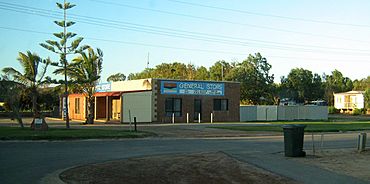Gregory, Western Australia facts for kids
Quick facts for kids GregoryWestern Australia |
|
|---|---|

Port Gregory general store
|
|
| Established | 1853 |
| Postcode(s) | 6535 |
| Elevation | 6 m (20 ft) |
| Area | [convert: needs a number] |
| Location |
|
| LGA(s) | Shire of Northampton |
| State electorate(s) | Moore |
| Federal Division(s) | Durack |
Gregory is a small town and fishing port in Western Australia. It was known as Port Gregory until 1967. This town is about 7 kilometres (4.3 miles) northwest of the Hutt River's mouth. It is part of the Mid West region.
In 2016, Gregory had a population of 64 people. Many of the houses are used for holidays. The number of people in Gregory changes a lot. It gets very busy during school holidays and in summer because of tourists.
Contents
Discovering Gregory's Past
The first European to visit this area was an explorer named George Grey. He camped near Hutt Lagoon on April 4, 1839. This was during his second trip along the Western Australian coast.
How Gregory Got Its Name
Port Gregory was first set up in 1849. It was originally called Boat Harbour. The town was named after two brothers, Augustus and Frank Gregory. They were famous explorers in Western Australia.
In May 1853, a group of 60 convicts and their guards arrived. They came from England by ship. These convicts were used for government work. They also helped build a road to the Murchison River. This road led to the Geraldine Lead Mine, which operated from 1849 to 1875. Convicts who had earned some freedom were hired to work at the port and on nearby farms.
Whaling and Mining History
Captain William Ayshford Sanford was a big employer in the area. He was also a magistrate and in charge of the convicts. He built a large home near Lynton. Later, he started whaling and farming. He set up a whaling station just north of the town. Other people, like John Bateman, also started whaling businesses nearby.
The town was officially named Pakington, but most people called it Port Gregory. This name came from the harbour next to the town. At first, the port was used by whalers and farmers. It also shipped lead ore from mines, especially the Geraldine mine. Salt from nearby Hutt Lagoon was also shipped from here. However, during a time of economic hardship, the port and both towns became empty.
A Surprising Attack
On January 27, 1943, a Japanese submarine was planning to attack Geraldton. But it saw some aircraft and what looked like a warship. So, it changed its plans. The next night, the submarine fired shells at Port Gregory. It fired about ten 100-mm (3.9-inch) shells. The submarine thought a crayfish factory was an ammunition factory. Luckily, there was no damage. Port Gregory was empty at the time. The navy only found out about the attack later when the submarine's radio message was decoded.
Shipwrecks and the Name Change
Many ships have been wrecked near Gregory. This is because the port was not suitable for large ships. These wrecks include trading and whaling vessels. One famous wreck is the screw steamer SS Xantho. It sank while carrying lead ore from the Geraldine mine.
The town officially changed its name from Port Gregory to Gregory in 1967.
Climate
Gregory has a warm-summer Mediterranean climate. This means it has warm winters with some rain. Its summers are hot and dry.


